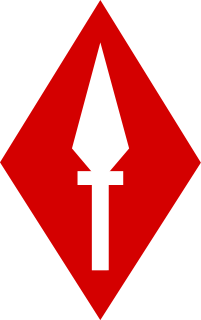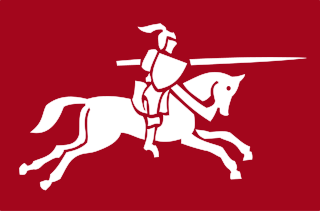Related Research Articles

I Corps was an army corps in existence as an active formation in the British Army for most of the 80 years from its creation in the First World War until the end of the Cold War, longer than any other corps. It had a short-lived precursor during the Waterloo Campaign.

XXX Corps was a corps of the British Army during the Second World War. The Corps was formed in the Western Desert in September 1941. It provided extensive service in the North African Campaign and many of its units were in action at the Second Battle of El Alamein in late 1942. It then took part in the Tunisia Campaign and formed the left flank during the Allied invasion of Sicily in 1943.

VIII Corps was a British Army corps formation that existed during the First and Second World Wars. In the latter, it took part in the Normandy Campaign in 1944, where it was involved in Operation Epsom and Operation Goodwood. It would later play a supporting role in Operation Market Garden and finish the war by advancing from the Rhine to the Baltic Sea.

An Army Group Royal Artillery (AGRA) was a British Commonwealth military formation during the Second World War and shortly thereafter. Generally assigned to Army corps, an AGRA provided the medium and heavy artillery to higher formations within the British Army.

1st Army Group Royal Artillery was a brigade-sized formation organised by Britain's Royal Artillery during World War II to command medium and heavy guns. It served in the final stages of the Tunisian Campaign and throughout the Italian Campaign. It reformed in the Territorial Army in the 1950s to command air defence units.

The 79th Armoured Division was a specialist armoured division of the British Army created during the Second World War. The division was created as part of the preparations for the Normandy invasion on 6 June 1944, D-Day.

The South Nottinghamshire Hussars is a unit of the British Army formed as volunteer cavalry in 1794. Converted to artillery in 1922, it presently forms part of 103 Regiment, Royal Artillery.

XII Corps was an army corps of the British Army that fought in the First and Second World Wars. In the First World War, it formed part of the British Salonika Force on the Macedonian front. In the Second World War, it formed part of the British Second Army during Operation Overlord and the subsequent North-West Europe Campaign of 1944-45.

The First Canadian Army was a field army and a formation of the Canadian Army in World War II in which most Canadian elements serving in North-West Europe were assigned. It served on the Western Front from July 1944 until May 1945.

The 77th Medium Regiment, was a Royal Artillery unit of Britain's part-time Territorial Army (TA) formed after the outbreak of World War II from a Yeomanry Cavalry regiment recruited in Lancashire. It landed in Normandy shortly after D Day and served through many of the largest battles of the campaign in North West Europe until VE Day.
The North Midland (Staffordshire) Heavy Battery was a Territorial Force (TF) unit of the Royal Garrison Artillery (RGA) formed in Staffordshire in 1908. It fought on the Western Front during World War I. Converted to medium artillery in the 1920s, the unit took part in the Battle of France and Dunkirk Evacuation in the early part of World War II, before returning to action in North Africa and Italy, and finally in North West Europe.
The London Heavy Brigade, Royal Garrison Artillery was a unit of the British Territorial Force formed in 1908. It fought on the Western Front during World War I, and its successors served in the Mediterranean and North-West Europe theatres during World War II.
59th Army Group Royal Artillery was an artillery formation of the British Army in World War II. Having operated in the North West Europe theatre in late 1944, it was switched to India to command artillery units preparing for the liberation of South-East Asia.
The 10th Medium Regiment, Royal Artillery, was a WW2 formed Medium Artillery regiment, enabled on 11 December 1942. The regiment was a conversion of the 16th Battalion, The Royal Fusiliers, which was part of 47th London Division. The conversion took place while the regiment was engaged in guarding the port and defences of Dover, Kent. The whole battalion moved to the North of England (Durham) and was joined by a number of OR's from the Royal Welsh Fusiliers, Gunnery Officers & NCO's from the regular army's 65th (Highland) Medium Regiment RA, to make up the War Establishment. The regiment was formed into two Batteries, 83 and 84, consisting of four 'Troops', each with four guns - a total of 16 guns for the regiment.

The 2nd Cinque Ports Artillery Volunteers was a part-time unit of the British Army's Royal Artillery from 1890 to 1955. Raised as coastal defence artillery, it later served as field artillery in Mesopotamia during the First World War and in the Battle of France and Second Battle of El Alamein during the Second World War. Its successor units later operated as medium artillery in North West Europe, and as jungle artillery in Burma. Postwar, it became an anti-aircraft unit.

The 191st Field Regiment was a unit of Britain's Royal Artillery (RA) formed during World War II. Created around experienced drafts from existing Territorial Army units, it trained as mobile artillery with an armoured division. Later it served through the campaign in North West Europe, supporting varied formations such as the Royal Marine Commandos, Royal Armoured Corps and Polish troops operating under First Canadian Army.

The Edinburgh City Artillery was a part-time unit of Britain's Volunteer Force raised in the City of Edinburgh in 1859. It was the parent unit for a number of batteries in the later Territorial Force, including heavy batteries of the Royal Garrison Artillery that fought on the Western Front during World War I. It later formed a heavy regiment that served in the Battle of France and the campaign in North West Europe during World War II, while a spin-off medium regiment fought in Sicily and Italy. Its successor units continued in the postwar Territorial Army until the 1960s.

2nd Army Group Royal Artillery was a brigade-sized formation organised by Britain's Royal Artillery (RA) during World War II to command medium and heavy guns. It served in the final stages of the Tunisian Campaign and throughout the Italian Campaign. It reformed in the Territorial Army in the 1950s to command air defence units.

8th Army Group Royal Artillery was a brigade-sized formation organised by Britain's Royal Artillery (RA) during World War II to command medium and heavy guns. It served in the campaign in North West Europe, participating in the battles in the Orne valley and the bocage south of Caumont before the breakout from the Normandy beachhead, operations to close up to the Maas, and the assault crossing of the Rhine.

The 9th Medium Regiment was a Royal Artillery unit, formed in the British Army during World War II. First raised in 1940 as infantry of the Buffs, it was converted to the medium artillery role in 1942 and fought in the campaign in North West Europe. It was disbanded after the war.
References
- 1 2 "THE HISTORY OF 9 ARMY GROUP ROYAL ARTILLERY". Archived from the original on 7 August 2008. Retrieved 14 October 2009.
- ↑ Arty-Boys. The History of 10th Medium Regiment Royal Artillery. ISBN 9780956651921